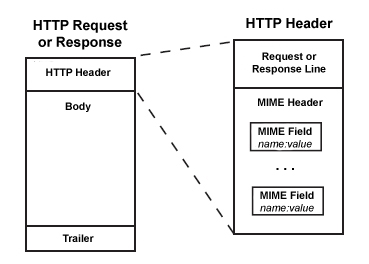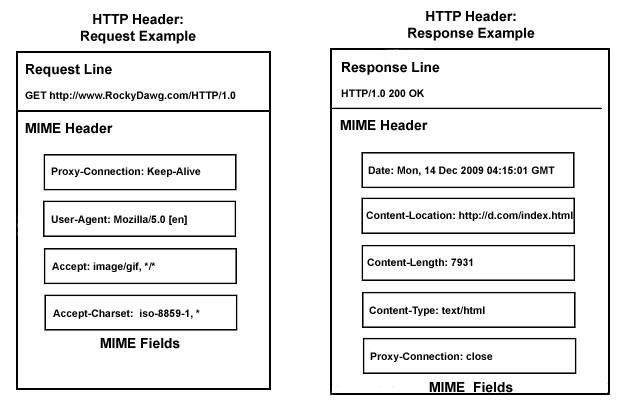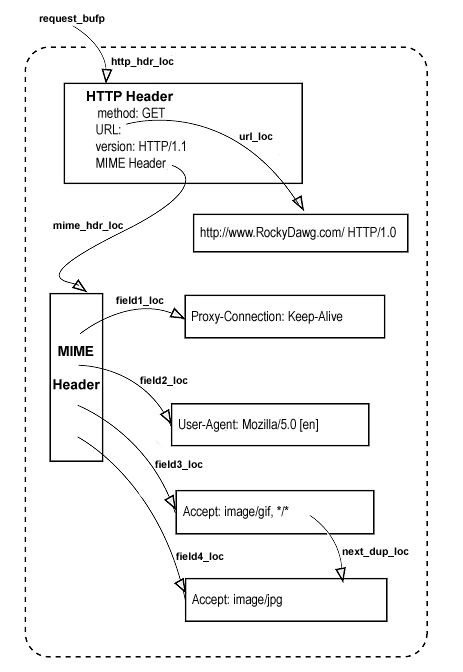HTTP Headers¶
An HTTP message consists of the following:
HTTP header
body
trailer
The HTTP header consists of:
A request or response line
An HTTP request line contains a method, URL, and version
A response line contains a version, status code, and reason phrase
A MIME header
A MIME header is comprised of zero or more MIME fields. A MIME field is composed of a field name, a colon, and (zero or more) field values. The values in a field are separated by commas. An HTTP header containing a request line is usually referred to as a request. The following example shows a typical request header:
GET http://www.tiggerwigger.com/ HTTP/1.0
Proxy-Connection: Keep-Alive
User-Agent: Mozilla/5.0 [en] (X11; I; Linux 2.2.3 i686)
Host: www.tiggerwigger.com
Accept: image/gif, image/x-xbitmap, image/jpeg, image/pjpeg, image/png, */*
Accept-Encoding: gzip
Accept-Language: en
Accept-Charset: iso-8859-1, *, utf-8
The response header for the above request might look like the following:
HTTP/1.0 200 OK
Date: Fri, 13 Nov 2009 06:57:43 GMT
Content-Location: http://locutus.tiggerwigger.com/index.html
Etag: "07db14afa76be1:1074"
Last-Modified: Thu, 05 Nov 2009 20:01:38 GMT
Content-Length: 7931
Content-Type: text/html
Server: Microsoft-IIS/4.0
Age: 922
Proxy-Connection: close
The following figure illustrates an HTTP message with an expanded HTTP header.
Figure 10.1. HTTP Request/Response and Header Structure

HTTP Request/Response and Header Structure¶
The figure below shows example HTTP request and response headers.
Figure 10.2. Examples of HTTP Request and Response Headers

Examples of HTTP Request and Response Headers¶
The marshal buffer or TSMBuffer is a heap data structure that stores
parsed URLs, MIME headers, and HTTP headers. You can allocate new
objects out of marshal buffers and change the values within the marshal
buffer. Whenever you manipulate an object, you must require the handle
to the object (TSMLoc) and the marshal buffer containing the object
(TSMBuffer).
Figure 10.3. Marshal Buffers and Header Locations

Marshal Buffers and Header Locations¶
The figure above shows the following:
The marshal buffer containing the HTTP request,
reqest_bufpTSMLoclocation pointer for the HTTP header (http_hdr_loc)TSMLoclocation pointer for the request URL (url_loc)TSMLoclocation pointers for the MIME header (mime_hdr_loc)TSMLoclocation pointers for MIME fields (fieldi_loc)TSMLoclocation pointer for the next duplicate MIME field (next_dup_loc)
The diagram also shows that an HTTP header contains pointers to the URL
location and the MIME header location. You can obtain the URL location
from an HTTP header using the function TSHttpHdrUrlGet. To work with
MIME headers, you can pass either a MIME header location or an HTTP
header location to MIME header functions . If you pass an HTTP header to
a MIME header function, then the system locates the associated MIME
header and executes the MIME header function on the MIME header
location.